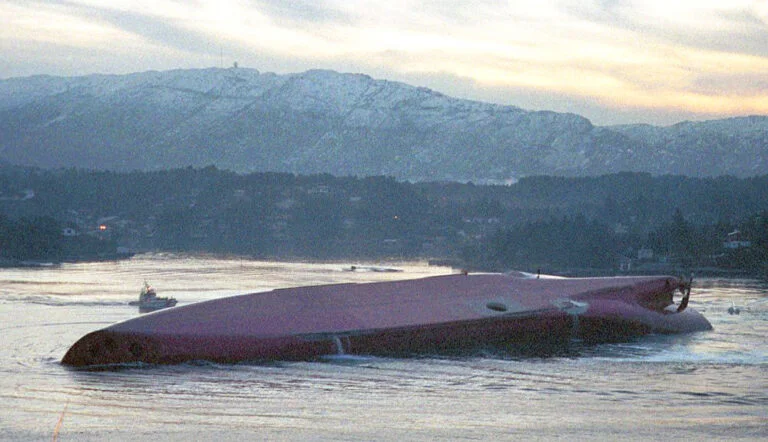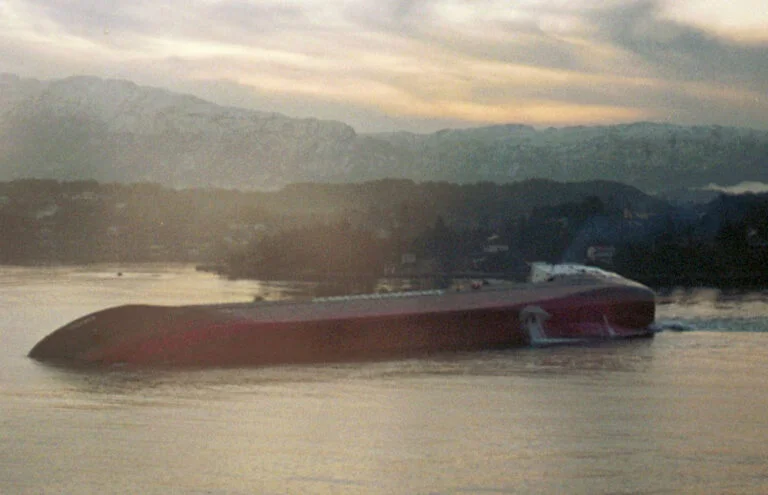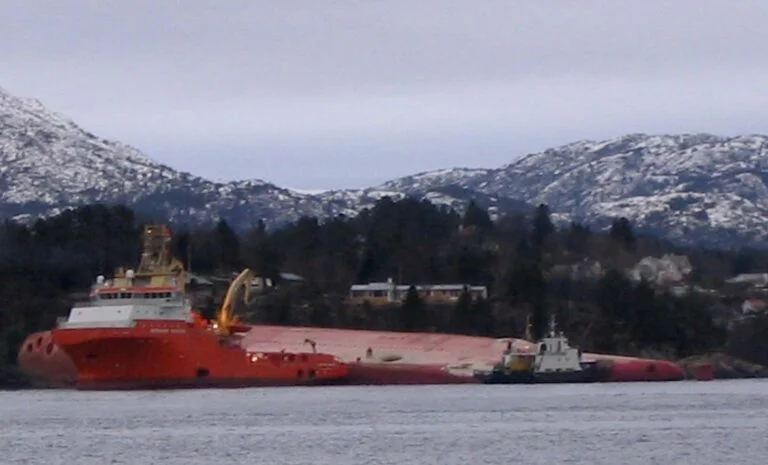When navigating through shallow waters near Bergen, the enormous cargo vessel MV Rocknes overturned, killing more than half its crew.
Watching disaster documentaries is one of my guilty pleasures. From plane crash investigations to insights from Chernobyl, I find them fascinating. Recently, the wonders of the YouTube algorithm presented me with a case I’d never heard about before, the Rocknes ship disaster of 2004.

I’ve previously written about natural disasters including the Tafjord tsunami and Gjerdrum landslide. This time, it was very much human error.
What happened?
In the winter of 2004, the 166-metre-long rock discharge vessel MS Rocknes was travelling through a winding fjord from Eikefet past Bergen on route to the open ocean and onto Germany.
There were 30 people on board, including a local pilot who was given responsibility for navigation through the narrow channels, something he had many years of experience with.
In the narrow channel Vatlestraumen, south of Bergen, the ship began to list to starboard. The list quickly became impossible to correct and the ship capsized in just a few minutes.

Many of the crew were trapped inside. Rescuers managed to save three people by cutting a hole in the hull to save them from the ‘bottom' of the ship. In total, 18 of the 30 crew lost their lives.
The vessel
Launched in 2001, MS Rocknes was owned by Kvitnes Shipping Company. It was on a long-term charter to international contractor Van Oord ACZ. At the time of the incident, it was the world's largest dynamically positioned flexible fall pipe vessel, also known as a rock dumping vessel.
Read more: The Most Likely Disasters in Norway
Such vessels carry rocks in the cargo hold. Through a series of conveyors and a pipe system that extends below the hull, they can lay down rocks on a very specific area. This is useful for securing subsea pipelines and laying protective rock close to civil engineering projects, for example.
Why did it happen?
As with most disasters, a combination of reasons led to the Rocknes ship disaster. The investigations turned up some worrying facts.
First, the ship’s design caused several problems. The large quantity of heavy equipment mounted above the main deck raised its centre of gravity, reducing stability.

The pilot also had visibility issues from the bridge, having to constantly walk across the bridge to get a complete visual understanding of the location.
During loading, the loose rock and gravel was not equally spaced across the hold. Despite receiving a warning, the crew chose not to level the cargo by hand. Instead, investigators believe they filled one of the ballast tanks with water to level out the ship.
When the ship turned into the channel, investigators believe the cargo began to shift, adding to the instability inherent in the ship’s design. The pilot appeared to be taking wide turns as sharp turns would have added to the problem.
Read more: Norway's Worst Air Accidents
One of the long turns took the Rocknes too far off the channel’s centre line and it hit rocks 23 metres off course. Paint found on rocks matching the Rocknes showed the rocks tore a hole in the starboard hull.
The pilot, who was the only person to escape the bridge, claimed the rocks were not included on maps. Although the rocks had been identified, pilots and other mariners were not properly notified via the “notice to mariners” procedure.
Who was to blame?
The immediate investigation by Norwegian authorities left responsibility for the accident undetermined. In 2009, the case was reopened as a trial of the ship owners and their insurance agents against the Government of Norway and its Hydrographic Service.
The judge found that the State was liable in not reporting the shoal. However, it also found negligence on the part of the owners and the operators of the ship (especially the ship's captain and pilot).
According to Hydro International, this meant the claimants were held responsible for 96% of the cost of the resultant damage and ultimately the grounding itself. These costs included ship damage and repairs, oil clean-up and claims made by families of the deceased.

